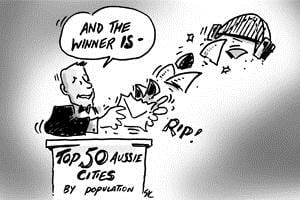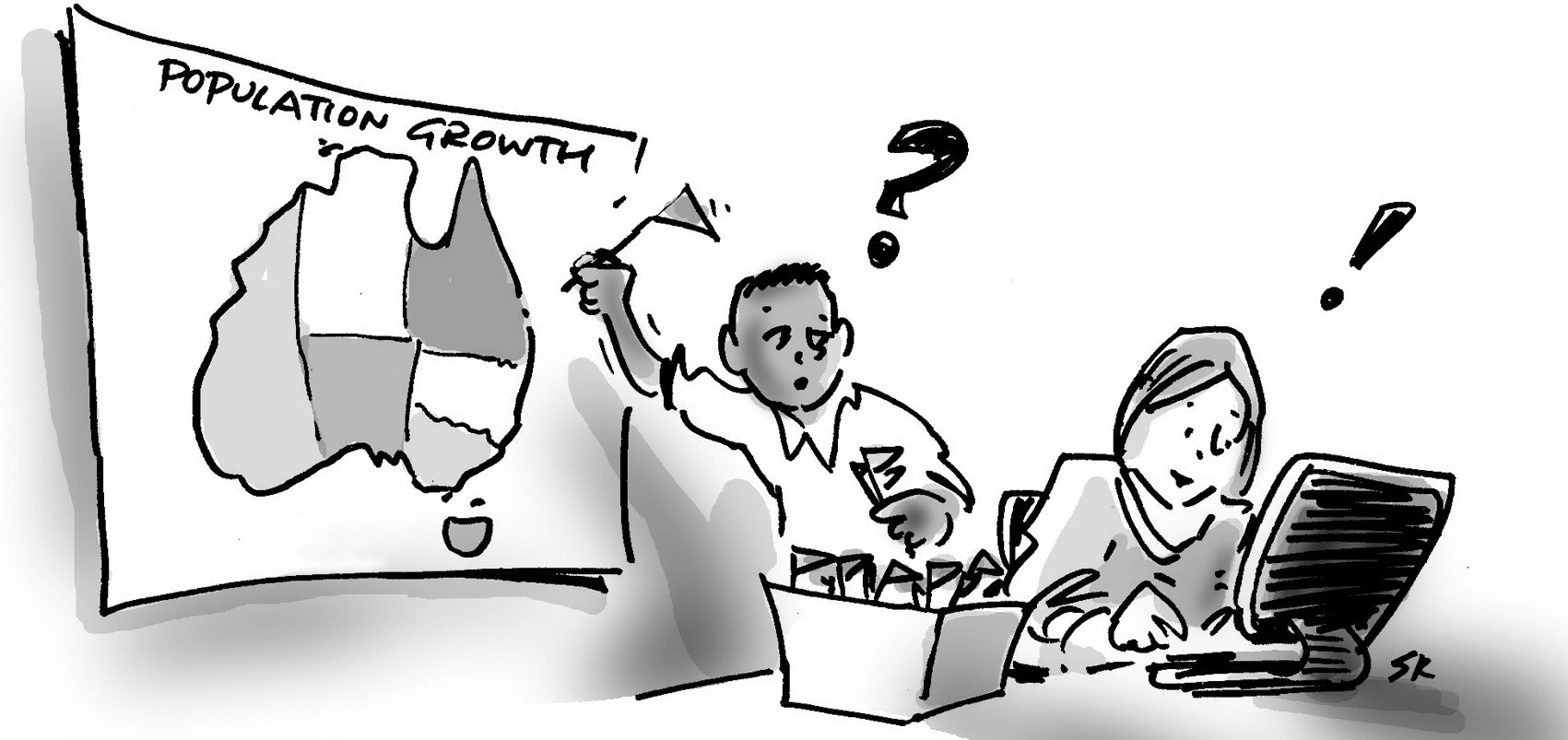BLOG
The 50 largest cities in Australia | 2021 update
The 50 largest cities in Australia | 2021 update
An updated (pandemic edition) of this blog has been published. See the 2022 table of Australia’s largest cities here.
In this update of our ever-popular blog series, Glenn looks largest urban centres in Australia based on the latest population estimates to June 2020. Everyone loves a ranking and here you can see the how Australia’s main urban areas stack up. The big news: Melbourne has overtaken Sydney!
Every year we get an update on local populations, which goes onto our Community Profile (profile.id) sites. Total population is the simplest demographic characteristic but also the most eagerly awaited. As part of this update, the ABS defines “Significant Urban Areas”, which allow us to re-rank Australia’s cities.
While Australia’s population growth slowed down in 2019-20, it didn’t stop. It probably will stop in 2021 – we have preliminary estimates at a national level which show negative growth for the September quarter 2020 – but much of 2019-20 was pre-COVID and the borders were still open.
Top 50 largest cities in Australia
| 5 year change | 1 year change | |||||
|---|---|---|---|---|---|---|
| Rank | Significant Urban Area | 2020 pop | no. | % | no. | % |
| 1 | Melbourne Vic | 4,969,305 | 545,542 | 12.3% | 74,522 | 1.5% |
| 2 | Sydney NSW | 4,966,806 | 419,479 | 9.2% | 54,475 | 1.1% |
| 3 | Brisbane Qld | 2,475,680 | 235,474 | 10.5% | 45,873 | 1.9% |
| 4 | Perth WA | 2,083,645 | 119,247 | 6.1% | 36,597 | 1.8% |
| 5 | Adelaide SA | 1,357,504 | 62,523 | 4.8% | 15,997 | 1.2% |
| 6 | Gold Coast – Tweed Heads Qld/NSW | 709,495 | 78,675 | 12.5% | 15,917 | 2.3% |
| 7 | Newcastle – Maitland NSW | 498,015 | 26,532 | 5.6% | 6,613 | 1.3% |
| 8 | Canberra – Queanbeyan ACT/NSW | 464,995 | 32,256 | 7.5% | 3,285 | 0.7% |
| 9 | Sunshine Coast Qld | 348,343 | 38,721 | 12.5% | 7,318 | 2.1% |
| 10 | Central Coast NSW | 337,284 | 12,188 | 3.7% | 1,860 | 0.6% |
| 11 | Wollongong NSW | 309,345 | 17,658 | 6.1% | 3,356 | 1.1% |
| 12 | Geelong Vic | 282,412 | 35,246 | 14.3% | 6,608 | 2.4% |
| 13 | Hobart Tas | 219,071 | 13,900 | 6.8% | 2,301 | 1.1% |
| 14 | Townsville Qld | 183,322 | 6,416 | 3.6% | 1,663 | 0.9% |
| 15 | Cairns Qld | 155,340 | 7,737 | 5.2% | 1,402 | 0.9% |
| 16 | Toowoomba Qld | 139,526 | 6,994 | 5.3% | 1,314 | 1.0% |
| 17 | Darwin NT | 133,268 | 2,171 | 1.7% | -220 | -0.2% |
| 18 | Ballarat Vic | 109,533 | 9,871 | 9.9% | 1,881 | 1.7% |
| 19 | Bendigo Vic | 102,499 | 8,464 | 9.0% | 1,509 | 1.5% |
| 20 | Albury – Wodonga NSW/Vic | 96,075 | 6,769 | 7.6% | 1,248 | 1.3% |
| 21 | Launceston Tas | 89,178 | 3,621 | 4.2% | 971 | 1.1% |
| 22 | Mackay Qld | 80,926 | – 184 | -0.2% | 664 | 0.8% |
| 23 | Rockhampton Qld | 79,602 | 493 | 0.6% | 524 | 0.7% |
| 24 | Melton Vic | 75,517 | 16,485 | 27.9% | 3,325 | 4.6% |
| 25 | Bunbury WA | 75,155 | 1,679 | 2.3% | 539 | 0.7% |
| 26 | Coffs Harbour NSW | 73,018 | 3,779 | 5.5% | 489 | 0.7% |
| 27 | Bundaberg Qld | 71,554 | 1,398 | 2.0% | 254 | 0.4% |
| 28 | Wagga Wagga NSW | 56,887 | 1,528 | 2.8% | 221 | 0.4% |
| 29 | Hervey Bay Qld | 55,975 | 3,546 | 6.8% | 642 | 1.2% |
| 30 | Shepparton – Mooroopna Vic | 52,529 | 2,368 | 4.7% | 424 | 0.8% |
| 31 | Mildura – Wentworth Vic/NSW | 52,319 | 1,739 | 3.4% | 141 | 0.3% |
| 32 | Port Macquarie NSW | 49,478 | 3,680 | 8.0% | 760 | 1.6% |
| 33 | Gladstone – Tannum Sands Qld | 45,938 | 306 | 0.7% | 306 | 0.7% |
| 34 | Tamworth NSW | 43,251 | 1,669 | 4.0% | 71 | 0.2% |
| 35 | Traralgon – Morwell Vic | 42,440 | 1,315 | 3.2% | 196 | 0.5% |
| 36 | Bowral – Mittagong NSW | 40,964 | 3,037 | 8.0% | 560 | 1.4% |
| 37 | Orange NSW | 40,888 | 1,666 | 4.2% | 91 | 0.2% |
| 38 | Warragul – Drouin Vic | 40,645 | 6,392 | 18.7% | 1,429 | 3.6% |
| 39 | Busselton WA | 40,326 | 3,460 | 9.4% | 700 | 1.8% |
| 40 | Dubbo NSW | 39,054 | 2,339 | 6.4% | 293 | 0.8% |
| 41 | Nowra – Bomaderry NSW | 38,314 | 2,114 | 5.8% | 482 | 1.3% |
| 42 | Bathurst NSW | 37,545 | 2,171 | 6.1% | 359 | 1.0% |
| 43 | Geraldton WA | 37,256 | – 1,449 | -3.7% | -7 | 0.0% |
| 44 | Warrnambool Vic | 35,887 | 1,520 | 4.4% | 365 | 1.0% |
| 45 | Albany WA | 34,587 | 820 | 2.4% | 212 | 0.6% |
| 46 | Devonport Tas | 30,877 | 1,002 | 3.4% | 248 | 0.8% |
| 47 | Mount Gambier SA | 29,946 | 541 | 1.8% | 180 | 0.6% |
| 48 | Kalgoorlie – Boulder WA | 28,911 | – 2,608 | -8.3% | -431 | -1.5% |
| 49 | Lismore NSW | 28,495 | – 616 | -2.1% | -76 | -0.3% |
| 50 | Nelson Bay NSW | 28,490 | 1,353 | 5.0% | 217 | 0.8% |
Melbourne overtakes Sydney (depending on your point of view)
Melbourne has overtaken Sydney to become Australia’s largest city!
The big proviso is that, as always, this list is based on “Significant Urban Areas”. These areas are based on an aggregate of SA2s, which contain the continuous urban extent of a city without major gaps. This differs from “Greater Capital Cities”, which are used as benchmarks in most of the .id sites and at the ABS. Greater Capital Cities are defined as broader labour market regions and extend further into rural districts within commuting distance of the capitals.
- This is the first time Melbourne has overtaken Sydney since Significant Urban Areas were defined.
- This has only happened when measuring the contiguous urban area. Using the labour-market definition of Greater Capital Cities, Sydney is still more populous by over 200,000. However Melbourne has been closing the gap there significantly too. Both cities are over 5 million by this measure. It’s still a big deal that our largest city is now Melbourne, when measured by urban extent (and I haven’t seen this mentioned in the media – the ABS didn’t really publicise this fact).
- The reason for the difference is that Sydney’s labour market (Greater City definition) includes the Central Coast (Australia’s 10th largest urban centre). This area is separated geographically by the Hawkesbury River and national parks from the rest of Sydney, so it is excluded on a Significant Urban Area basis.
- Based on current growth rates, it would take another 9 years (so, 2029) for Melbourne to overtake Sydney on a Greater Capital City basis. Of course with population decline in Australia likely from 2021, this could change dramatically.
Some other takeaways
- There are no new entries or dropouts from the previous year – the 50 cities are the same as they were a year ago, and indeed 3 years ago.
- Aside from the big Melbourne vs Sydney story, there are a few reshuffles in the pecking order this year.
- Melton – a big growth area on the outskirts of Melbourne, which is part of the Melbourne Greater Capital City, but a separate Significant Urban Area – rises 2 places to #24.
- Shepparton-Mooroopna overtakes Mildura-Wentworth to #30.
- Bowral-Mittagong in the NSW Southern Highlands overtakes Orange for #36.
- Warragul-Drouin in Victoria’s Gippsland region overtakes Busselton, WA, to move into 38th position.
- Four of the top 50 cities experienced population declines in 2019-20. These were the same four as last year: Darwin, Geraldton, Lismore and Kalgoorlie-Boulder. Expect a lot more declines in 2020-21.
- To be a top 50 Australian city now needs a population of greater than 27,535 people, the population of Burnie-Wynyard, Tasmania, which is at #51.
- If you don’t see your local area in the list but you think it has a large enough population, that’s most likely because it’s considered part of a larger urban centre. While we’ve already discussed that Central Coast is separate from Sydney and Melton is separate from Melbourne on a Significant Urban Area definition, other areas are included with those cities. For example, Pakenham, Vic, is now part of Melbourne’s significant urban area, and Camden in NSW is part of Sydney. The most common questions we get are about the Logan, Ipswich and Moreton Bay regions in Queensland. These three are all part of the Brisbane Significant Urban Area, except for some outlying parts which are too small to be considered part of any Signifcant Urban Area.
These populations are shown here for interest – everyone loves a good league table! Populations for Local Government Areas, suburbs, districts and other small areas have now been updated on Community Profile for all our Local Government and regional clients. You can also see the updated LGA populations on our National Demographic Indicators series page.
Glenn - The Census Expert
Glenn is our resident Census expert. After ten years working at the ABS, Glenn's deep knowledge of the Census has been a crucial input in the development of our community profiles. These tools help everyday people uncover the rich and important stories about our communities that are often hidden deep in the Census data. Glenn is also our most prolific blogger - if you're reading this, you've just finished reading one of his blogs. Take a quick look at the front page of our blog and you'll no doubt find more of Glenn's latest work. As a client manager, Glenn travels the country giving sought-after briefings to councils and communities (these are also great opportunities for Glenn to tend to his rankings in Geolocation games such as Munzee and Geocaching).










